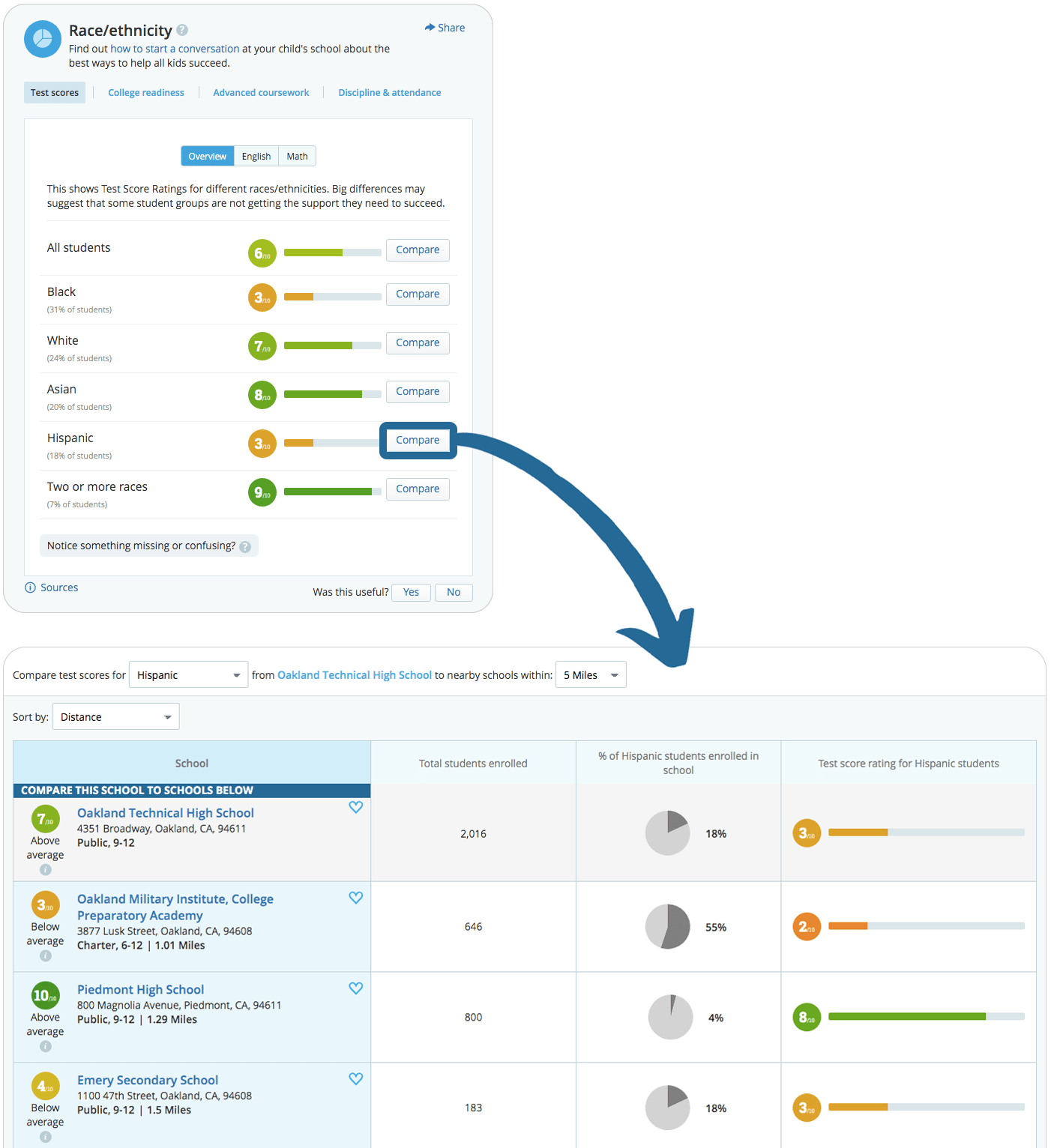Want all kids to get a fair shake?
This 5-part toolkit will help you advocate
for students of all backgrounds.



Most schools have an achievement gap. This means that some groups of students have higher scores on standardized tests.
GreatSchools’ Equity Rating shines a light on how well schools are doing at helping all students succeed. A low Equity Rating means the test scores of low-income and other disadvantaged groups are much lower than those of other students at the school.
Equity is a measure that matters to everyone. A high equity rating means a school is doing a good job of teaching its students new skills and concepts. It takes a highly effective school to teach kids who don’t have a lot of advantages.

Some high schools have figured out how to help all students succeed no matter their background. Here are some things that make a difference.
#1Make advanced academics accessible
Students who take advanced classes are more likely to:
High schools with the best track records of preparing students for college provide lots of advanced classes. They make those opportunities available to everyone. In fact, successful high schools encourage all kids to try these classes. Some schools enroll all students in an advanced class.
But research shows enrollment is not enough. Schools also need to offer extra support to help struggling students succeed in those classes. Successful strategies include: free tutoring, access to teachers outside of class time, and study skills classes.
#2Reach out to at-risk students
Studies show that struggling students benefit from extra support. One-on-one tutoring, emotional counseling, small-group advisories all help students catch up.
Research shows 9th grade is a critical year for students falling off track. For this reason, most high schools have adopted practices of identifying “at risk” students in 9th grade. Successful high schools do not stop in 9th grade. They continue to look for students who are falling off track all the way through the 12th grade. This focus on not letting any student fall through the cracks is an important strategy to close the achievement gap.
#3Offer college counseling
Students who receive personal college counseling are more likely to enroll in a four-year college. This includes help filling out applications and providing financial aid resources.
Hands-on college support is particularly important for students from disadvantaged backgrounds. College counselors and academic guidance counselors often provide this support. But successful high schools have also solved this problem in other ways. Some high schools have college students help high school students apply for college. Others create a college application class taught by teachers. Whatever the solution, students need hands-on help with:
#4Hold high expectations for all students
Five decades of research show that the expectations teachers have for their students affects how well they do. It’s part of a teacher’s job to make decisions based on their beliefs about their students. They assign students to project groups. They call on students in class (or don’t). These beliefs can lead to excluding some students from challenging learning opportunities. They may not get access to: advanced classes and special projects. Research shows racial bias sometimes limits teachers’ understanding of their students’ potential. In one study, teachers regarded white and Asian students as high achievers compared to black and Latino students, even when the students had identical grades. This research suggests that teachers hold low expectations for certain students regardless of their abilities.
Research also shows that expectations influence how well students do. When students believe that teachers have low expectations for them, those expectations become a self-fulfilling prophecy. By contrast, when schools set high expectations and provide lots of support, all students can achieve at a high level.
#5Start in middle school
In districts where middle and high schools work closely together, good things happen. Students get used to their high school’s expectations earlier. Students also have the opportunity to build longer-lasting relationships with teachers. Finally, staff can identify and intervene with at-risk students earlier.
All districts can create more pathways between middle and high schools. They can build more continuity into the curriculum. They can also build programs that connect the middle schools to the high schools in a community.
#6Provide pathways for all students
Successful high schools give students the ability to explore careers, whether they’re college bound or not.
Some high schools have very divided tracks. Some kids take college prep or AP or honors classes. Others pursue more vocational tracks. The best high schools allow all students to explore college-bound as well as career pathways without tracking them. Gaining career skills makes high school feel more relevant. Students exposed to career and technical programs are more likely to graduate from high school. Plus, they are just as likely to pursue a four-year degree as their peers.

Visit your school’s profile on GreatSchools.org. What’s your schools’ Equity Rating? This is a number that shows how well a school is educating all kids. Now get the details. Scroll down to where it says Race/Ethnicity and you can see test scores, measures of college readiness, and even discipline and attendance broken down by race and ethnicity. Then, scroll down to the Low-income Students section to see this same information for students from different socio-economic backgrounds.
How does your high school compare to other local schools? Click the button that says “Compare.” You’ll be able to see at a glance how this school compares in terms of serving different groups of kids. The “compare test scores for” drop-down menu lets you see how low-income students or students of different races and ethnicities are doing at schools near yours.

If you notice that there are big gaps in academic outcomes or attendance or suspension rates between different groups of students, you may want to find out how the school is responding. Here are 5 questions to ask the principal.
“I notice that there’s a gap in academic outcomes/attendance/suspension rates. What is the school doing to address this challenge?”
Listen for: Special programs, tutoring, new policies, etc. to close gaps and concrete, measurable school goals.
“Do the teachers receive any training to help them hold all children to high standards?”
Listen for: Concrete ways that help teachers make sure they have high expectations for all students.
“How is progress measured to ensure that all students are learning?”
Listen for: Assessments to gauge student learning.
“How is the school working to support struggling students?”
Listen for: Specific actions that support low-performing students. Ex: proven teaching strategies, extra academic support, peer tutoring, and parent engagement. How many children take advantage of these resources? How do parents know about this extra help?
“Do all students have equal access to the most challenging classes? Or are some students tracked into remedial or general education classes?”
Listen for: How the school encourages all students to take stretch classes and avoids permanent “ability grouping.” Ask to see the demographics of the students in advanced courses vs. remedial courses.

Copy and paste this note into an email to your principal, school board, and/or district superintendent to share what you’ve learned about equity and let them know this issue is important to you. Fill in the blanks below to send a personal message with the data you found on your school page on GreatSchools.
Dear Principal ____________,
I’m concerned about equity at our school. I notice that there’s a big gap in ____________ (academic outcomes / ap classes / attendance / suspension / graduation rates etc.) for ____________ (low income, black, female, students with disabilities etc.) students.
I’m aware that gaps like these are common in high schools across the nation. Research suggests that most schools struggle to serve all students equitably, and it’s a priority for most educators. Some schools have figured out strategies that support struggling students and ensure every student is treated equitably. Here are some examples of research-based practices that have helped other schools support struggling students and hold universally high standards.
I also know that there are schools with similar demographics as ours that don’t have such big gaps between student groups. Here are a couple: ____________, ____________. (Choose one of these Spotlight schools nationally or use the Compare Tool in Part #3 above to find more equitable schools in your community.)
Closing the achievement gap is crucial to creating a successful school for all students and making sure the next generation has the skills they need to address the challenges of this world. I would love to hear about the programs and initiatives underway at our school to help close these gaps and if appropriate, offer my support for these initiatives.
Thank you for your hard work on behalf of all students.
Sincerely,